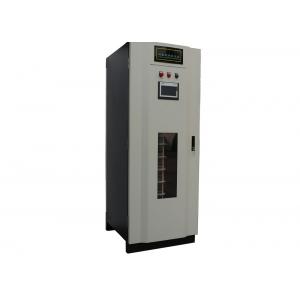
Add to Cart
Onsite Sodium Hypochlorite Generator For Drinking Water From Weak Brine Water
Product Description
0.8% Sodium hypochlorite generation system is producing sodium hypochlorite onsite through 3% brine electrolysis(salt and water after saturated), and the whole system is a combination of Softening unit, Filtration unit, Salt dissolving unit, Online proportioning unit, electrolytic unit, rectifier power supply, automatic control systems, storage and dosing unit, etc.
Sodium Hypochlorite is widely used in many water industries. The most applied in drinking water disinfection, on site generation of Sodium hypochlorite is more safely than feeding chlorine gas. Transporting Chlorine gas tank is risky to leakage and lead to explosion.
Generation principle:
The sodium chloride contained in seawater or brine flow between sets of electrodes (anodes and cathodes) in an electrolyzer.
The chemical reactions which take place in the electrolyzer between chlorine and Sodium hydroxide produced by electrolysis.
In the electrolyzer the sodium chloride is completely dissociated into the ions Na+ and Cl-, causes the following electrochemical and chemical reactions:
Electrode reaction:
at the anode: 2Cl- - 2e → Cl2;
at the cathode: 2H+ + 2e → H2;
Solution reaction:
2NaOH + Cl2 → NaCl + NaClO + H2O
Overall reaction as follow:
NaCl + H2O + DC →NaClO + H2↑
Process
1. Influent water is passed through a water softener.
2. Using softened water to dissolve the salt in a tank to form a concentrated brine solution.
3. Diluted into 2.5%-3% after filtered (If use sea water as raw material, it will be treated before electrolysis)
3. The diluted brine is electrolyzed to a 0.8% solution of sodium hypochlorite.
4. The 0.8% hypochlorite solution flows into a storage tank.
5. The sodium hypochlorite solution will be injected into the pipe by metering pump.
6. The residual chlorine detector will monitor residual chlorine and return feedback to the PLC center.
7. According to preset standards, the PLC Center will adjust the speed of the dosing pump.
Compared with commercial sodium hypochlorite disinfection methods
| Disinfection method | On-site Sodium hypochlorite | Commercial Sodium hypochlorite | |
| product | It produce a solution of strengths 0.8% and the only | By-product of the chlor-alkali industry, with a concentration of 10%, containing an excess of alkali and harmful impurities | |
| Attenuation | Without attenuation | Attenuation of 5% per day, and also cause excessive Chlorine in drinking water | |
| Safety | Safety disinfection method, environmental non-toxic. | Dangerous articles. Risk during transport and storage and easily caused degradable when storage. Short time storage and high transport costs. | |
| Disinfection by-products | Due to weak in chlorine oxidation ability, three material are less, and combined additive, ammonia, potassium permanganate, less by-products | The raw material is Industrial salt, which contain harmful impurities in drinking water and it is bad for health. | |
| Economic analysis | The investment is a little higher in the early time, but the operation cost is low, and after three or four years it can pay your investment money back | Equipment cost is low, but the high cost of running, and the running costs cannot be controlled | |
| Dosing Accuracy | Dosing liquid low concentration, can accurately control the amount of chlorine | High concentration, difficult to precisely control the amount of chlorine |
Process |
